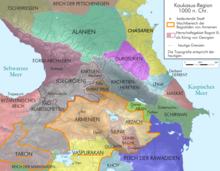Kingdom of Abkhazia
The Kingdom of Abkhazia ( Abkhazian Аҧсуа аҳра ; Georgian აფხაზეთის სამეფო ), also Egrisi-Abkhazia , was a medieval , feudal kingdom. The empire comprised the area of today's Abkhazia , but in the north larger areas of today's Russian Krasnodar region and in the south and east significant parts of today's Georgia also belonged to the Kingdom of Abkhazia. It existed as an independent state from around 780 and was founded in 1008 as part of a dynastic unification in the Kingdom of Georgia .
history
The kingdom of Lasika (also called “Egrisi” in Georgian) was Christianized in the 6th century, but fell apart in the 7th / 8th. Century into several small principalities. One of the successor states was the Principality of Abkhazia , which was created under Byzantine protection through the expansion of the Abkhazian tribal union (from Georgian: "apchasi"; also "Abasgen" from Greek "Abasgoi") . The Abkhaz rulers were subordinate to Byzantium as archons . After attacks by the Arabs from the middle of the 8th century, Leon II (Levan II) finally achieved complete independence of the country with the help of the Khazars .
Under Levan II, the Kingdom of (Egrisi-) Abkhazia arose around 780 from a dynastic connection between his principality Abkhazia and the younger Egrisi (such as the Mingrelia region ), a remnant of the old Lasikas, which he inherited from his wife. Levan II conquered further areas in the east and south and moved the capital Anacopia to Kutaisi . In the following years the kingdom expanded, in the 860s the Inner Kartlien could be occupied, but it was lost again at the end of the century. In the middle of the 10th century Abkhazia had taken parts of the Javakheti region and in the north the influence also grew on the Alans .
From the second half of the 10th century, revolts and unrest broke out in the country, particularly under Theodosius III. escalated. As a result, the empire had to largely cede its leading role in the region. Theodosius died childless in 978.

After internal disputes over the throne, Theodosius' nephew Bagrat III finally became . from the house of the Georgian Bagratids the new King of Abkhazia in the same year. Bagrat had been ruler of Tao-Klardschetien since 975 . In 1008 the two empires finally merged, and the dynastic union created the Kingdom of Georgia .
The Kingdom of Abkhazia is now taken over by both Abkhazians and Georgians . There were several tribal associations in the region, the linguistic assignment of which is controversial. Since then, the language that has been handed down in writing has been the Georgian language due to its membership in the Georgian Church .
See also
Individual evidence
- ↑ http://www.bbc.co.uk/news/world-europe-18175030
- ↑ Heinz Fähnrich: History of Georgia from the beginnings to Mongol rule . Shaker publishing house, Aachen 1993.
- ↑ W.Barthold; V. Minorsky: "Ab kh āz" in: The Encyclopaedia of Islam. New Edition (EI2) Volume 1, p. 100.
- ↑ a b c d e W.Barthold ; V. Minorsky : “Ab kh āz” in: EI2 Volume 1, pp. 100–102.
